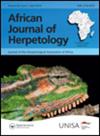13鳞绿蛇Philothamnus carinatus的系统分类学(鳞目:蛇科),并附中非和东非一隐秘性新种的描述
IF 0.9
4区 生物学
Q2 Agricultural and Biological Sciences
引用次数: 0
摘要
摘要非洲绿蛇的分子系统发育研究表明,分布广泛的非洲绿蛇至少包括两个不同的分支。我们利用形态学和遗传数据的综合分类方法来协调这些隐谱系的分类地位,包括最近描述的西非P. brunneus分类群。我们测序了三个线粒体基因(16S, cyt b和ND4)和两个核基因(c-mos和RAG1),并将我们的数据与其他近缘物种相结合,用IQ-TREE推断出最大似然系统发育树。我们的研究结果与之前的研究结果一致,这些研究表明,刚果民主共和国(DRC)的p.c f. carinatus种群代表了一个不同于喀麦隆、中非共和国、赤道几内亚(包括比奥科岛)、加蓬、尼日利亚东部、刚果共和国和刚果民主共和国西部的p.c r . carinatus sensu stricto的神秘血统。在我们的首选树中,P. brunneus(仅限于16S分子数据)被恢复为与P. carinatus(狭义carinatus)在一个中等支持的分支中相对较长的分支,而P. cf. carinatus来自安哥拉北部、刚果民主共和国大部分地区和东非(布隆迪、肯尼亚、卢旺达、坦桑尼亚和乌干达)的种群被描述为一个新种。喀麦隆东南部和刚果民主共和国西北部之间可能存在杂交种群,这与越来越多的证据一致,这些证据表明乌班吉河可能代表一个杂交区。我们感谢Jonathan Brecko和Garin Cael为获取RMCA标本提供了便利;Bo Delling和Andrea Hennyey的NRM型标本;马克。Rödel和frank Tillack的ZMB类型;Jennifer Sheridan和Stevie Kennedy-Gold的CM标本;Kevin de Queiroz, Robert Wilson和Addison Wynn制作USNM标本;和Nicolas Vidal的MNHN标本。Marius Burger, Kate Jackson和J. Maximilian Dehling提供了carinatus Philothamnus的照片。Everett Madsen提供了一些模式标本的照片。EG在刚果民主共和国的实地工作由Percy Sladen纪念基金、IUCN/SSC两栖动物专家组种子基金、K. Reed医学博士、Villanova大学生物系的研究基金、两项国家地理研究与探索基金(8556-08和w - r018 -17)、UTEP和美国国家科学基金会(DEB-1145459)资助。我们感谢自然科学研究中心的项目支持和许可(CRSN-LW1/28 /BB/MM/BIR/050/07, 2008年的无编号许可,LWI/27/BBa/MUH)。米/作用/ 141/09,LWI / 27 / BBa / mu。米/作用/ 023/10,LWI / 27 / BBa / mu。米/作用/ 001/011,LWI / 27 / BBa /天蓝色/作用/ 003/012,LW1/27 / BB / KB /作用/ 60/2014,LWI / 27 / BBa /作用/ 146/014),研究所Congolais倒拉保护大自然de la许可证(ICCN-unnumbered许可证由省级ICCN主任赤道省在2013年8月,姆班达卡004 / ICCN / PNKB / 2013、06 / ICCN / PNKB / 2014、02 / ICCN / PNKB / 2015),和特级研究所d 'Ecologie倒拉自然保护de la (, ISEC Katana-ISEC / DG / SGAC / 04/2015 / DG / SGAC / ISEC 04/29/2016)。VG感谢Ernest Vunan提供的后勤支持,并感谢Oldřich Kopecký在喀麦隆实地提供的帮助,在喀麦隆,材料是根据喀麦隆科学研究和创新部(MINRESI: 00132/MINRESI/B00/C00/C10/C13)和林业和野生动物部(MINFOF: 1010/PRBS/MINFOF/SG/DFAP/SDVEF/SC)颁发的许可证收集的。David Modrý因提供了Dzanga-Sangha (CAR)的材料而受到认可,这些材料是在中非共和国国家教育部、alphabsamtisation、enseignement supsamrieur和de la Recherche以及世界野生动物基金会的许可下收集的,而灵长类动物习惯化计划则提供了后勤支持。VG的工作得到了捷克科学基金会(23-07331S)和捷克共和国文化部(DKRVO 2019-2023/6.VII)的支持。e,国家博物馆,00023272)。作者特别感谢边境生物医学研究中心(BBRC)基因组学分析核心设施的Ana Betancourt所提供的服务和设施。这项工作得到了美国国立卫生研究院(NIH)下属的国家少数民族健康与健康差异研究所(NIMHD)的5U54MD007592基金的支持。披露声明作者未报告潜在的利益冲突。本文章由计算机程序翻译,如有差异,请以英文原文为准。
Systematics of the Thirteen-scaled Green Snake Philothamnus carinatus (Squamata: Colubridae), with the description of a cryptic new species from Central and East Africa
ABSTRACTRecent molecular phylogenies of African green snakes suggested the geographically widespread species Philothamnus carinatus includes at least two distinct lineages. We utilised an integrative taxonomic approach with morphological and genetic data to reconcile the taxonomic status of these cryptic lineages, including the recently described taxon P. brunneus from West Africa. We sequenced three mitochondrial (16S, cyt b and ND4) and two nuclear (c-mos and RAG1) genes from several Central African populations of P. carinatus and combined our data with other closely related species to infer a maximum likelihood phylogenetic tree with IQ-TREE. Our results are consistent with previous studies that showed P. cf. carinatus populations from Democratic Republic of the Congo (DRC) represent a cryptic lineage that is distinct from P. carinatus sensu stricto in Cameroon, Central African Republic, Equatorial Guinea (including Bioko Island), Gabon, eastern Nigeria, Republic of the Congo, and extreme western DRC. In our preferred tree, P. brunneus (limited to 16S molecular data) was recovered as a relatively long branch in a moderately supported clade with P. carinatus sensu stricto, whereas P. cf. carinatus populations from northern Angola, most of DRC, and East Africa (Burundi, Kenya, Rwanda, Tanzania and Uganda) were described as a new species. A possible hybrid population between south-eastern Cameroon and north-western DRC is consistent with an increasing body of evidence suggesting the Ubangi River might represent a hybrid zone area.KEYWORDS: Congo RiverUbangi RiverCongo Basinendemism ACKNOWLEDGEMENTSWe thank Jonathan Brecko and Garin Cael for facilitating access to RMCA specimens; Bo Delling and Andrea Hennyey for NRM type specimens; Mark-O. Rödel and Franck Tillack for the ZMB type; Jennifer Sheridan and Stevie Kennedy-Gold for CM specimens; Kevin de Queiroz, Robert Wilson and Addison Wynn for USNM specimens; and Nicolas Vidal for MNHN specimens. Marius Burger, Kate Jackson, and J. Maximilian Dehling contributed photos of Philothamnus carinatus. Everett Madsen provided some photos of type specimens. Fieldwork by EG in DRC was funded by the Percy Sladen Memorial Fund, an IUCN/SSC Amphibian Specialist Group Seed Grant, K. Reed, M.D., research funds from the Department of Biology at Villanova University, two National Geographic Research and Exploration Grants (8556-08 and WW-R018-17), UTEP, and the US National Science Foundation (DEB-1145459). We are grateful to the Centre de Recherche en Sciences Naturelles for project support and permits (CRSN—LW1/28/BB/MM/BIR/050/07, an unnumbered permit from 2008, LWI/27/BBa/MUH.M/BBY/141/09, LWI/27/BBa/MUH.M/BBY/023/10, LWI/27/BBa/MUH.M/BBY/001/011, LWI/27/BBa/CIEL/BBY/003/012, LW1/27/BB/KB/BBY/60/2014, LWI/27/BBa/BBY/146/014), Institut Congolais pour la Conservation de la Nature for permits (ICCN—unnumbered permit by Provincial Director of ICCN, Équateur Province in Mbandaka in August 2013, 004/ICCN/PNKB/2013, 06/ICCN/PNKB/2014, 02/ICCN/PNKB/2015), and Institut Supérieur d’Ecologie Pour la Conservation de la Nature (ISEC, Katana—ISEC/DG/SGAC/04/2015, ISEC/DG/SGAC/04/29/2016). VG would like to thank Ernest Vunan for logistical support and Oldřich Kopecký for assistance in the field in Cameroon, where the material was collected under permits issued by the Cameroon Ministry of Scientific Research and Innovation (MINRESI: No. 00132/MINRESI/B00/C00/C10/C13) and Ministry of Forestry and Wildlife (MINFOF: No. 1010/PRBS/MINFOF/SG/DFAP/SDVEF/SC). David Modrý is acknowledged for providing material from Dzanga-Sangha (CAR), which was collected with permits from Ministère de l’Education Nationale, de l’Alphabétisation, de l’Enseignement Supérieur et de la Recherche of the Central African Republic and the World Wildlife Fund, while the Primate Habituation Programme provided logistical support. The work of VG was supported by the Czech Science Foundation (23-07331S) and Ministry of Culture of the Czech Republic (DKRVO 2019–2023/6.VII.e, National Museum, 00023272). The authors would like to express special thanks to Ana Betancourt of the Border Biomedical Research Center (BBRC) Genomics Analysis Core Facility for services and facilities provided. This work was supported by Grant 5U54MD007592 from the National Institute on Minority Health and Health Disparities (NIMHD), a component of the US National Institutes of Health (NIH).Disclosure statementNo potential conflict of interest was reported by the author(s).
求助全文
通过发布文献求助,成功后即可免费获取论文全文。
去求助
来源期刊
CiteScore
2.60
自引率
6.70%
发文量
0
审稿时长
>12 weeks
期刊介绍:
African Journal of Herpetology (AJH) serves as an outlet for original research on the biology of African amphibians and reptiles. AJH is an interdisciplinary journal that publishes original articles and reviews from diverse fields and disciplines, such as conservation, phylogenetics, evolution, systematics, performance, physiology, ecology, behavioural ecology, ethology, and morphology.
The Journal publishes two issues a year. There are no page charges .

 求助内容:
求助内容: 应助结果提醒方式:
应助结果提醒方式:


